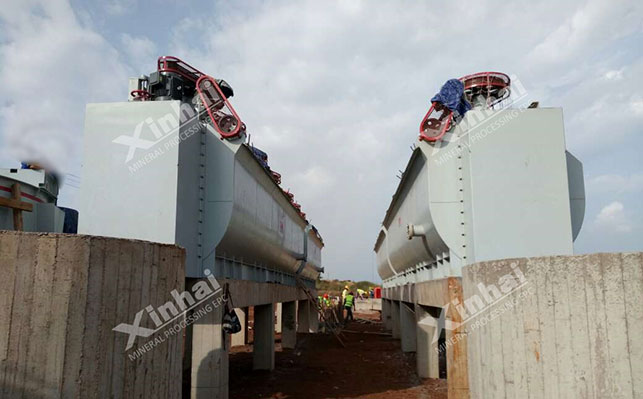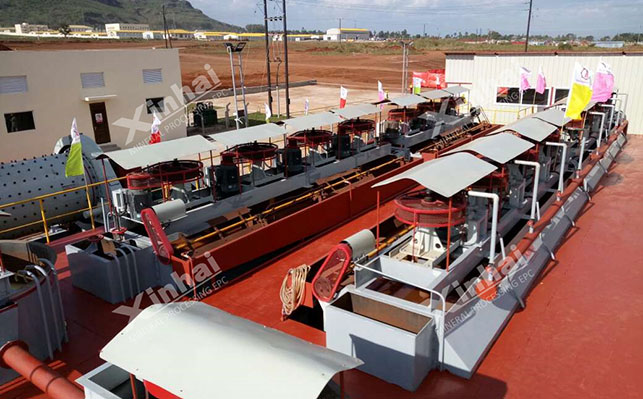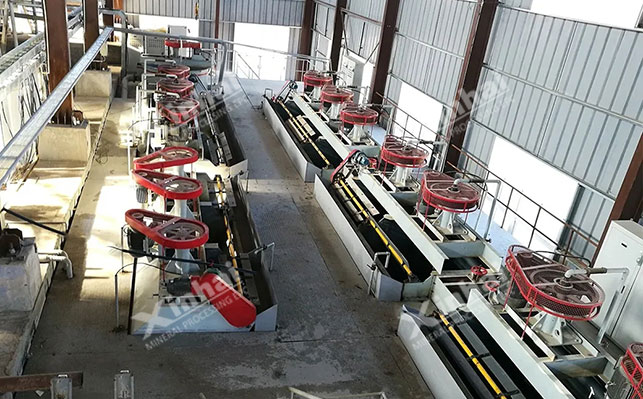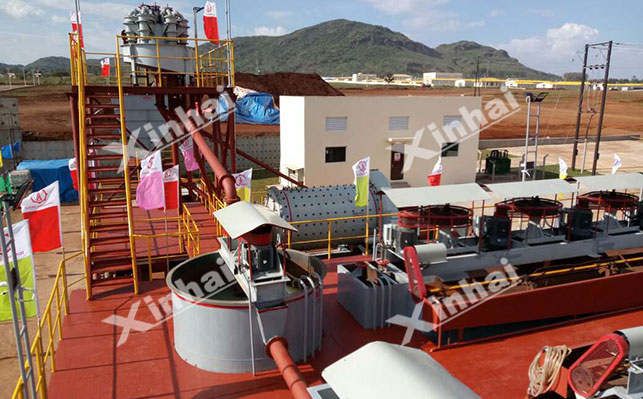
15311826613
Click to add WeChatIn the field of phosphate ore resource development, flotation is an important means of mineral processing, and the grade of the ore is one of the key factors that determine its feasibility. Recently, a customer came to consult about the question of how much phosphorus grade can be flotated. Let's answer this question and list several common phosphate ore flotation methods.

Usually, the conventional requirement for the grade of ore in phosphate ore flotation is P₂O₅≥5% (boundary grade), and the industrial economic grade usually needs to be ≥15%. However, whether the flotation process can be used in practice cannot be judged only by grade, but also needs to be considered in combination with multiple factors such as ore type, impurity content, and mineral processing cost.
For example, is apatite an easy-to-select type or a colloidal phosphate type? Whether the content of SiO₂, MgO, and Fe₂O₃ in phosphate ore exceeds the standard, or whether phosphorus is wrapped by sulfide gangue, etc., these are the criteria for whether phosphate ore can be floated.
Phosphorus ore type: The type of phosphate ore directly determines the difficulty of flotation and the choice of process. Apatite has a regular structure, high degree of crystallization, good floatability, and is an easy-to-select ore; while colloidal phosphate often exists in cryptocrystalline or colloidal state, closely coexists with gangue minerals, has poor floatability, and is a typical difficult-to-select ore, requiring a more complex process and reagent system.
Phosphorus impurity content: When the SiO₂ content is greater than 20%, the quality of phosphate concentrate will be significantly reduced, and reverse flotation process is usually required for desiliconization; excessive MgO content will affect the efficiency of phosphate fertilizers and needs to be removed in a targeted manner; Fe₂O₃ not only affects the appearance of the product, but may also interfere with the flotation process and must be strictly controlled.
Embedding: If the phosphate mineral is tightly wrapped by sulfide or gangue, it is necessary to determine the reasonable grinding particle size through grinding fineness test to ensure the full dissociation of phosphate minerals and avoid over-grinding leading to increased energy consumption and deterioration of flotation indicators.
Target concentrate grade: Different application fields have different requirements for the grade of phosphate concentrate. When used to produce phosphate fertilizers, the P₂O₅ grade requirement is relatively low; when used in the field of fine chemicals, there are strict requirements for P₂O₅ content, impurity types and content. Clarifying the target concentrate grade is also the key to selecting flotation technology and formulating technical indicators.
Commonly used phosphate ore flotation methods mainly include positive flotation, reverse flotation and double reverse flotation.

Direct positive flotation: suitable for ores with large differences in surface properties between phosphate minerals and gangue minerals and good floatability of phosphate minerals. Generally, fatty acid collectors such as oleic acid and sodium oleate are used, which can selectively adsorb on the surface of phosphate minerals, making them hydrophobic and floating, while gangue minerals remain in the pulp. This method has a simple process and relatively low cost, but it has high requirements on the properties of the ore.
Heating positive flotation: For some difficult-to-select phosphate ores, especially those containing more impurities such as carbonates, heating positive flotation can be used. During the flotation process, raising the slurry temperature to the range of 40-90°C can enhance the adsorption capacity of the collector on the surface of the phosphate mineral, while reducing the floatability of impurity minerals and improving the grade and recovery rate of the phosphate concentrate. However, heating flotation consumes more energy and increases production costs.
For siliceous phosphate ore, reverse flotation is often used, which can be divided into two types: desiliconization reverse flotation and demagnesium reverse flotation.
Desiliconization reverse flotation: When the content of siliceous impurities (such as quartz) in the phosphate ore is high, desiliconization reverse flotation can be used. Generally, inhibitors (starch, water glass) are added first to inhibit phosphate minerals, and then cationic collectors (dodecylamine) are added to float siliceous minerals, so that the phosphate minerals remain in the pulp as concentrates.
Magnesium removal reverse flotation: If the content of magnesium impurities (such as dolomite and magnesite) in phosphate ore is high, it will affect the quality of phosphate concentrate and subsequent processing and utilization. At this time, magnesium removal reverse flotation can be used. Sulfuric acid, phosphoric acid, etc. are usually used as adjusters to reduce the pH value of the pulp, and then fatty acid collectors are added to float magnesium minerals, and the phosphate minerals are left in the pulp as concentrates.
When the phosphate ore contains both carbonate and siliceous gangue, double reverse flotation can be used. That is, one reverse flotation is performed to remove one impurity, and then another reverse flotation is performed to remove another impurity. The usual process is to first add an inhibitor to inhibit phosphate minerals, and use a collector to float carbonate gangue; then add another collector to float siliceous gangue, and finally obtain phosphate concentrate. Double reverse flotation can effectively remove a variety of gangue minerals and improve the quality of phosphate concentrate, but the process is long, the reagent system is complex, and the cost is relatively high.

When the phosphorus (P₂O₅) content in the raw ore reaches 15% or more, this type of phosphate ore has the basic conditions for direct flotation. In terms of process selection, the conventional positive flotation method can accurately attach to the surface of phosphate minerals and separate them from gangue minerals by relying on the high efficiency of fatty acid collectors (such as oleic acid and sodium oleate). This method has a simple process and convenient operation. If there are more silicon or magnesium impurities in the ore, reverse flotation is preferred. By adding inhibitors and collectors in a targeted manner, silicon and magnesium impurities can be effectively removed to improve the grade of phosphate concentrate.
For low-grade phosphate ore with a phosphorus (P₂O₅) content of 5%-15%, the economic benefits of direct flotation are not ideal, and pre-enrichment or combined processes are required. Among them, the spiral chute, shaking table and other equipment in the gravity separation technology can effectively discard a large amount of waste rock and improve the grade of the selected minerals by utilizing the density difference between phosphate minerals and gangue minerals; while the bioleaching technology selectively dissolves phosphate minerals with the help of the special metabolic action of microorganisms, or reduces the interference of fine mud in the slurry by scrubbing and desludging, reduces the subsequent flotation load, and creates favorable conditions for subsequent flotation.
The above introduces the grade requirements, flotation methods and flotation strategies for different grades of phosphate ore. Regardless of whether flotation is used or which flotation is used, the phosphate ore itself must be considered first. In order to accurately evaluate the feasibility of phosphate ore flotation, Xinhai can conduct mineral processing test analysis for it, and it is recommended to provide 1-2kg ore samples. According to the test analysis, it can finally design a suitable phosphate ore flotation plan for it, and can also provide a complete set of phosphate ore beneficiation equipment and subsequent overall installation and operation services of the beneficiation plant.

Uganda 720t/d Phosphate Ore is a mining industry chain service project undertaken by Xinhai Mining. Through experimental analysis, the process flow designed for it is: desludging-one closed-circuit grinding-one coarse, one sweep, two fine flotation-fine tailings dewatering process flow. In order to meet the requirements of modern enterprises for the production environment, Xinhai Mining has achieved the principle of combining source control and tailings treatment for it, reducing pollution. The entire beneficiation project has low investment, short construction period and quick results.